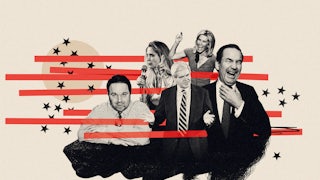The statutes around independent contracting are decades old and don’t reflect change in technology, the workplace, or current workplace structures.
—United States Chamber of Commerce, January 2021
Businesspeople talk about the gig economy, about which the Labor Department just issued a proposed rule, as if it were something innovative and new. In fact, it dates to the mid-sixteenth century, when master craftsmen first gave their apprentices “piece work” to do at home. Rather than pay these workers a salary, they paid them by the completed piece of work. This evolved, in London and New York City, into the “sweating system,” wherein garment workers were paid by the piece working on sewing machines in sweatshops—typically, overcrowded tenement apartments that were breeding grounds for tuberculosis and cholera.
The Triangle Shirtwaist Company was essentially a gig company minus the smartphone app and with the addition of a shared workspace behind locked doors (to discourage work breaks) high above Greenwich Village’s Washington Square. Women received somewhere between $1.50 per week and $12 per week depending on how fast they could sew a “shirtwaist,” which was a kind of buttoned-down blouse. In 1911, 146 of these hardy entrepreneurs died in a famous fire, most of them jumping from windows to escape the flames and smoke. Among those watching in horror from below was Frances Perkins, a 31-year-old lobbyist for the Consumers’ League of New York. The experience radicalized Perkins and, 27 years later, as U.S. labor secretary and the first woman ever to hold any Cabinet post, she became principal author of the 1938 Fair Labor Standards Act.
The FLSA permanently robbed many independent contractors of their “freedom” to work 12 hours a day, seven days a week, and to be paid whatever price the purchaser of their labor saw fit. It established a minimum hourly wage of 25 cents, required time-and-a-half pay for anyone who worked more than 44 hours per week (lowered soon after to 40), put strict limits on child labor, and defined, very broadly, what an “employee” was. This last feature was quite deliberate. Common law defined the employer-employee relationship, Perkins felt, too narrowly. She wanted businesses to take responsibility for the people who performed work for them.
That view is today considered old-fashioned, but it’s not as old-fashioned as the view that workers should have no protections at all. Studies show that somewhere between 10 percent and 30 percent of today’s workforce in the United States consists of people misclassified under current law as independent contractors so that employers can dodge paying minimum wage, overtime, payroll tax, unemployment insurance, and any other benefits they give their “real” employees. A 2009 Government Accountability Office study concluded that misclassification cost the Treasury nearly $3 billion each year. That was based on old data and is almost certainly too low.
The Labor Department’s proposed regulation would make it harder than it is right now for businesses to classify people who work for them as independent contractors. Naturally, it’s occasioning bellyaching from the business lobby. It will “foster massive confusion, endless litigation, reduced innovation, and fewer opportunities for employees and independent contractors alike,” griped the National Retail Federation to Rebecca Rainey of Bloomberg Law. Stock prices for Uber and Lyft tumbled Tuesday on news of the proposed rule. But all the rule does, really, is bring Labor Department policy back in line with the FLSA’s statutory language and nine decades of judicial interpretation that followed, most especially United States v. Silk and Rutherford Food Corp. v. McComb, two 1947 Supreme Court cases that established an “economic reality” test typically based on six questions:
- Are the services integral to the business?
- How great are the worker’s facilities and equipment?
- How much control does the business maintain over the worker?
- How great are the worker’s opportunities for profit and loss?
- How much does success depend on the worker’s foresight or judgment?
- How permanent is the relationship?
Depending on the answers to these questions, a worker may be classified either as an independent contractor or an employee. If the worker is an independent contractor, they are not entitled to receive the minimum wage or overtime pay. A recent study of rideshare drivers in California, who are all classified as independent contractors, found their median wage to be $6.20 per hour. If they were employees, that level of pay would constitute wage theft by Uber and Lyft under both federal law (which sets an hourly minimum of $7.25) and California law (which sets it at $15). Independent contractors are also in most cases denied unemployment insurance and must pay higher payroll taxes.
The Trump Labor Department, shortly before President Donald Trump left office and under the leadership of Eugene Scalia (son of Antonin), previously a management-side attorney on labor matters, issued a rule that said the questions regarding control and profit and loss should take precedence. This had the effect of making it much easier to classify a worker as an independent contractor. It also defied the FLSA’s statutory language, Supreme Court precedent, and past practice. The Biden administration tried to toss the rule out, but a district court judge in Texas wouldn’t allow that. So now it’s gone through the more formal process of crafting a new regulation that essentially reinstates the previous economic reality test.
The proposed Biden rule is nowhere near as strict as the so-called “ABC test,” which places the burden of proof on the employer and has been enacted by 20 states and the District of Columbia. (In California, it was enacted in 2019, then tossed out by voters in 2020 after a furious lobbying campaign by Uber and Lyft. In August 2021, a California Superior Court judge ruled the ballot proposition unconstitutional, but the ABC test is being held in abeyance while various gig companies appeal that ruling.) The ABC test says the worker is an employee unless they are free from control or direction, performs work apart from the company’s usual business, and performs work for other companies too. The Labor Department considered applying the ABC test but concluded that would not be in line with the Fair Labor Standards Act and its judicial interpretations.
Is the new rule a terrible blow to the gig economy? Only if you presume the gig economy was struggling before the Trump deregulation took effect in 2021. In any case, the notion that the gig economy is The Future is just wrong. We all think the gig economy is how the world works now because many of us have gotten used to Uber and Airbnb. But it’s actually pretty small. The part of the gig economy that lives in your iPhone—the digitized gig economy—constitutes less than 1 percent of the workforce. In 2018, the Bureau of Labor Statistics examined the question of whether the proportion of the workforce filing as independent contractors was growing and found, to its surprise, that it was not—at 7.4 percent, it had actually shrunk since 2005.
The workforce has been “fissuring” for the past half-century, to borrow a term from David Weil, former wage and hour administrator at the Obama Labor Department and author of the influential 2014 book The Fissured Workforce. Gig work is part of that, but it appears to be a relatively small part compared to the growth of subcontracting and franchising. Still, be glad that the Biden administration is cracking down on this dishonest practice, which impoverishes workers and allows companies like FedEx (which classifies its truck drivers as independent contractors) an unfair advantage in competing with companies like UPS (which does not). The gig economy is not the future, but it’s too much of the present, and the Labor Department’s new regulation will help.






